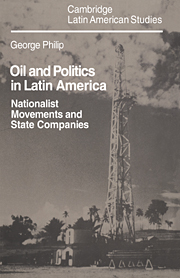Book contents
- Frontmatter
- Contents
- List of tables
- Preface
- Glossary
- Abbreviations
- Note on currencies and other units of measurement
- Maps: Latin America in 1920, 1940, 1960 and 1981; showing importing countries, exporting countries and countries self-sufficient in oil
- Introduction: The politics of oil in twentieth-century Latin America
- Part I The world oil environment
- Part II The major expropriations
- Part III The state oil companies
- 17 Pemex in Mexican politics 1938–79
- 18 The development of Petrobrás: oil company to conglomerate?
- 19 ypf 1932–1979: public enterprise or bureaucracy?
- 20 Petroperú 1968–80: achievements and hard lessons
- 21 ypfb and the development of oil in Bolivia
- 22 Petrovén: the birth of a giant
- 23 State oil companies in Latin America
- 24 Concluding reflections
- Notes and bibliography
- Index
- CAMBRIDGE LATIN AMERICAN STUDIES
24 - Concluding reflections
Published online by Cambridge University Press: 23 December 2009
- Frontmatter
- Contents
- List of tables
- Preface
- Glossary
- Abbreviations
- Note on currencies and other units of measurement
- Maps: Latin America in 1920, 1940, 1960 and 1981; showing importing countries, exporting countries and countries self-sufficient in oil
- Introduction: The politics of oil in twentieth-century Latin America
- Part I The world oil environment
- Part II The major expropriations
- Part III The state oil companies
- 17 Pemex in Mexican politics 1938–79
- 18 The development of Petrobrás: oil company to conglomerate?
- 19 ypf 1932–1979: public enterprise or bureaucracy?
- 20 Petroperú 1968–80: achievements and hard lessons
- 21 ypfb and the development of oil in Bolivia
- 22 Petrovén: the birth of a giant
- 23 State oil companies in Latin America
- 24 Concluding reflections
- Notes and bibliography
- Index
- CAMBRIDGE LATIN AMERICAN STUDIES
Summary
Much of the economic history of the twentieth century could be written around the oil industry. In 1896 the world produced 114.2 million barrels of oil; in 1974 the figure was 20,338 million. Apart from the major changes in the industrial and political geography of oil extraction, the availability of oil has been essential to the development of aviation, automobiles and the vast chemical industry. The century has also seen major technical changes within the oil industry itself. To mention only the more striking developments, drilling techniques were revolutionised during the 1920s, catalytic cracking was introduced into refining in the 1930s and the natural gas industry was developed within the USA. Petrochemical and pipeline developments followed the Second World War, as did the increasing sophistication of crude oil recovery techniques, while serious offshore exploration began in the 1960s.
It is worth mentioning all of this in order to make the point that oil wealth and the value of crude oil reserves did not simply exist but had to be created by the development of oil-consuming industry, by world economic growth and by the development of increasingly sophisticated techniques to extract and transport oil and gas. These developments created the conditions which allowed the oil-producing countries to transform the international market to such an extent after 1970.
Thus, in the years before 1928 the oil companies were clearly engines of growth and were welcomed throughout Latin America, despite their occasional barbarities and general lack of sympathy for the aspirations of poor countries.
- Type
- Chapter
- Information
- Oil and Politics in Latin AmericaNationalist Movements and State Companies, pp. 494 - 502Publisher: Cambridge University PressPrint publication year: 1982



